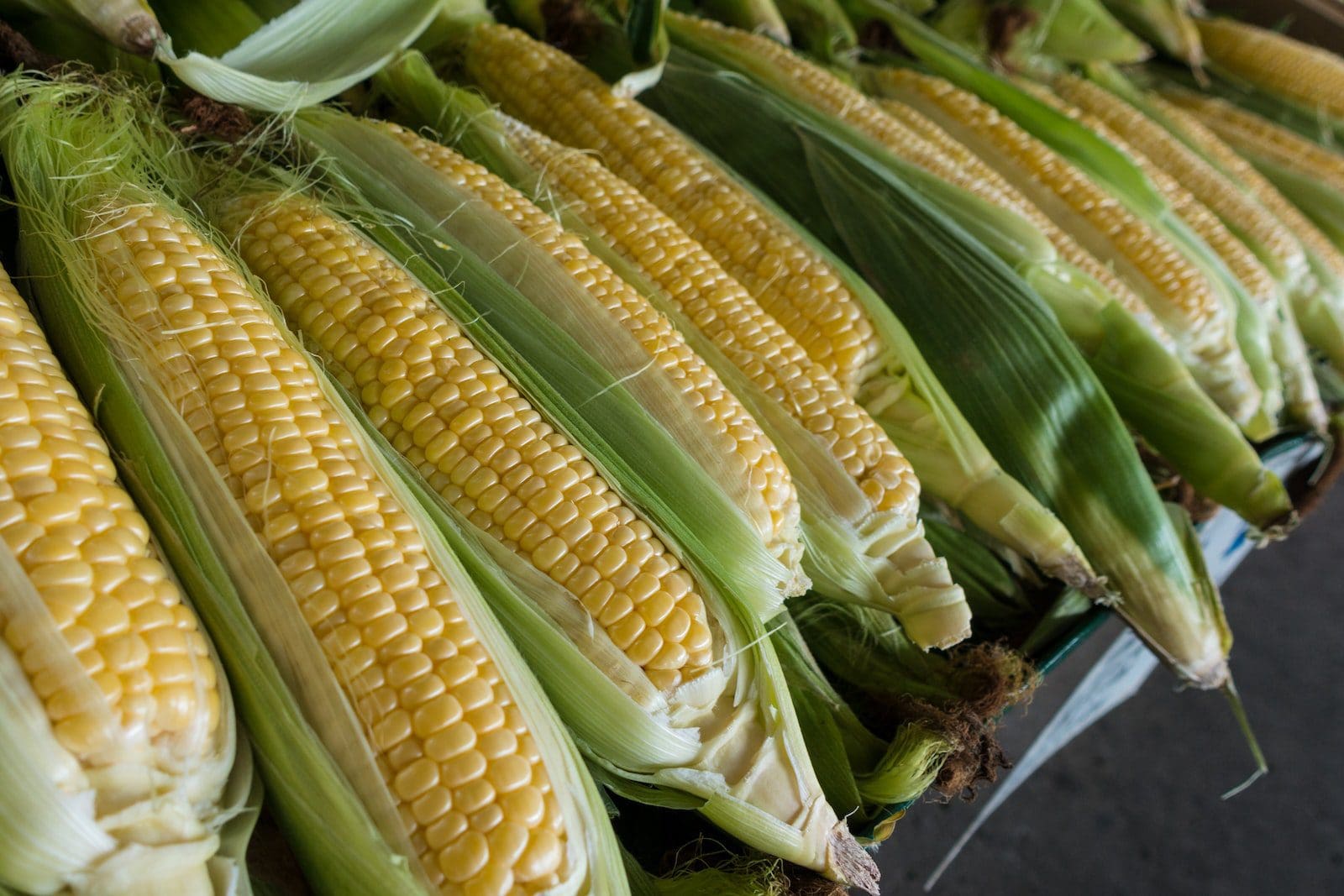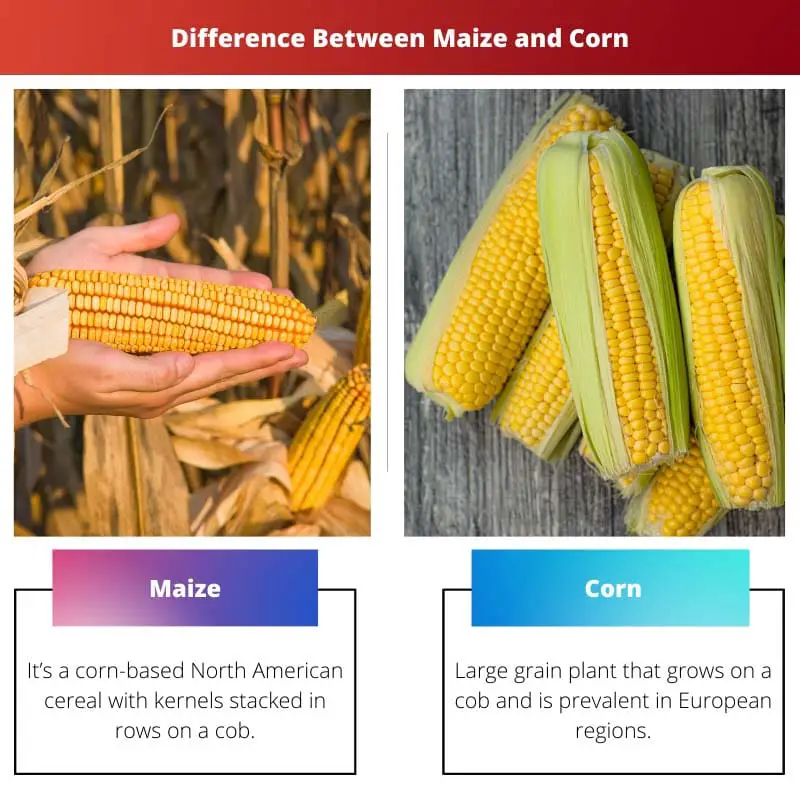This might be interpreted as two words that are completely distinct from one another and are analogous to those found in British English and American English, but they could also mean much more.
Key Takeaways
- Maize is a corn commonly used for food products like cornmeal and corn syrup.
- Corn is a general term that refers to various types of grains that come from the family of Zea mays.
- Maize and corn are used interchangeably in some countries, but there are differences in their botanical classification and usage.
Maize vs Corn
Maize is a cereal crop widely grown for food, animal feed, and industrial purposes. It is a grass family member and native to Central America, but it is now grown worldwide. Corn is a term used in American English for the same crop that is known as maize in British English. Corn is a cereal crop widely grown for food, animal feed, and industrial purposes.

Maize is one of the most technical names for corn, and it comes from the Spanish language “Maiz”, which became part of the English language in the mid of 16th century.
Corn flour, corn starch, cornmeal, and other culinary items manufactured from corn are termed corn rather than maize. Corn is simply maize and does not contain any other grains when we talk about commodities trade.
Comparison Table
| Parameters of Comparison | Maize | Corn |
|---|---|---|
| Definition | It’s a corn-based North American cereal with kernels stacked in rows on a cob. | large grain plant that grows on a cob and is prevalent in European regions. |
| Language | English as it is spoken in the United States. | English of United Kingdom. |
| Fame | In Australia, Canada, and New Zealand it is more well-known. | More well-known in European countries. |
| Origin | From the Taino language in the 14th century. | was used throughout the 19th century. |
| Usage | A tall cereal grass with big ears producing kernels. | Any type of grain or even peppercorn can also be used as a little object. |
What is Maize?
This was probably the most practical historical period for the term corn, and it comes from the Spanish word maiz, which entered the English community in the 16th century.
When the grains of the cob are in their natural state and aren’t cooked or ready to eat, they’re referred to as maize, and when they’re cooked or ready to eat, they’re referred to as corn.
Because of its popularity and the vitamins, it contains, it may be the maximum eaten cereal on the planet. The majority of people like to eat it alone, but in rare cases, they will get it with a fried or dry rooster or take it as a part of the salad.
It is the earliest word used for these qualities, initially used maize in 1492 when Columbus discovered it in front of many Taino people and is the distinction of all the terms maize and corn.

What is Corn?
It is commonly assumed to be the other type of well-known maize; this is not always the case.
This reasoning may be correct in certain cases, but it is mostly a North American cereal made from kernels that may be placed across the rows on a corn cob.
It can be used in British English to refer to a single tiny item. Corn was a consequence of the Dutch words Korn and was subsequently incorporated into the English language.
Corn is sometimes considered a synonym for the word maize or is used for the very same purpose in British English. It is used to stage tiny items that may represent any type of even peppercorn or grain.
This time is far less commonly used across the world, owing to the growth of American English, and it is undoubtedly one of many strange expressions that are not authentic.

Main Differences Between Maize and Corn
- Maize is the common name for this crop, whereas Corn is a newer name.
- In the 14th century, maize came from the Taino language. Corn was utilized throughout the nineteenth century.

- https://www.sciencedirect.com/science/article/pii/S2211912418300312
- https://academic.oup.com/jee/article-abstract/104/5/1584/924508

The clarification between maize in American English and corn in British English is well articulated. The further division of maize and corn in the text helps in understanding their botanical classification and usage.
The text provides a very clear explanation of the differences between corn and maize. Both are relevant not just in American and British settings, though. Despite the common usage of ‘corn’ in the US, ‘maize’ is still the scientific term. I love the usage of the comparison table, very useful.
I have to agree, the comparison table is quite effective for highlighting the differences.
The botanical and linguistic explanation provided adds depth to the understanding of the subject. Great post!
Absolutely, the interconnection between languages, terminologies and scientific classification is engaging.
The text’s detailed analysis of the origin, usage, and language distinction between maize and corn is remarkable. It’s informative and engaging.
The depth and clarity of the analysis make it an enjoyable read.
It’s fascinating how different geographic locations and spoken languages led to the varied usage of the terms ‘corn’ and ‘maize’. The etymology of the words gives an interesting perspective.
Agreed, the evolution of language and terms through history is quite intriguing.
The etymology indeed adds an enriching layer to the discussion.
This is quite informative. I didn’t know that maize is actually older than corn. The historical context provided is very interesting and significantly adds to the knowledge of the subject.
Indeed, the historical insights shed a light on the evolution of terminologies and geographical influences.
The references provided further validate the credibility of the information. The comprehensive analysis and sourcing make for a compelling read.
I completely agree, the reliance on credible sources enhances the text’s value.
Absolutely, having reputable references increases the credibility of the information presented.
The comparison table effectively summarizes the key differences between maize and corn. It’s a great visual aid to comprehend the distinctions.
I agree, the comparison table is a key element in making the information easily digestible.
I appreciate the clear distinction between maize and corn. The text does a great job of breaking down these terms and their historical and geographical relevance.
The historical context definitely enhances the understanding of these commonly used terms.
Absolutely, the text does an excellent job of providing clarity on the subject.
The historical connotations and linguistic variances are intriguing. The text provides a comprehensive understanding of these terms.
Indeed, the text successfully delves into the historical and linguistic aspects of maize and corn.
Absolutely, it’s a well-elucidated exploration of the subject.